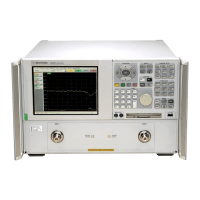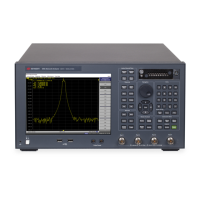Service Guide E8364-90038 4-21
PNA Series Microwave Network Analyzers Troubleshooting
E8362C, E8363C, E8364C Rear Panel Troubleshooting
5. The analyzer attempts four cycles of communications with the indicated LAN device.
• It displays the time it took to complete each cycle.
• Each cycle times-out after one second if no communication is established and the message, Request
timed out, is displayed.
• It is common for the first of the four cycles to time-out even though subsequent cycles pass.
• See below for an example output of a successful ping.
C:>ping 141.121.69.162
Pinging 141.121.69.162 with 32 bytes of data:
Reply from 141.121.69.162: bytes=32 time<10ms TTL=127
Reply from 141.121.69.162: bytes=32 time<10ms TTL=127
Reply from 141.121.69.162: bytes=32 time<10ms TTL=127
Reply from 141.121.69.162: bytes=32 time<10ms TTL=127
Ping statistics for 141.121.69.162:
Packets: Sent = 4, Received = 4, lost = 0 <0% loss>.
Approximate round trip times in milli-seconds:
Minimum = 0ms, Maximum = 0ms, Average = 0ms
6. The above message verifies that one way communication from the analyzer to the network has been
established
7. If the subnet mask was changed in step 2, set it back at this time.
How to Ping from the Local Area Network (LAN) to the Analyzer
Reverse communication should also be verified. Determining this, though, is dependent upon your network
setup and software. Generally, you need to issue a ping command using the IP address of the analyzer to be
tested. For example, using Windows 95, 98, 2000 and while at a DOS prompt, type in ping xxx.xxx.xxx.xxx
1
.
Then press
Enter on the front panel or keyboard. If full communication can be established, then the computer
display shows the cycle time for each of four cycle attempts (similar to that in step 5). Other software may
behave somewhat differently, but basically the same.
If the analyzer can talk to the network, but the network can not talk to the analyzer, then the computer or
device used from the network may have a subnet mask that excludes communication with the IP address
chosen for the analyzer. Any subnet mask other than 0.0.0.0 will exclude operation from some addresses.
Changing the subnet mask of a computer or other device should only be attempted by a qualified network
administrator. Failure to communicate due to a subnet mask incompatibility does not indicate any failure of
the analyzer.
If the analyzer fails to ping in either direction, and assuming the subnet masks are set properly, then the fault
must be isolated to the analyzer or to the network. Contact a qualified network administrator.
Tes ting Be twe en Two Analyz ers
The ability of the analyzer's LAN to function can be easily tested by connecting two analyzers together using
a “crossover cable” (a short length of cable with an RJ-45 connector on each end).
Some network hubs have the capability to make a crossover connection using two normal, or
1. The letters x represent the IP address of the analyzer.

